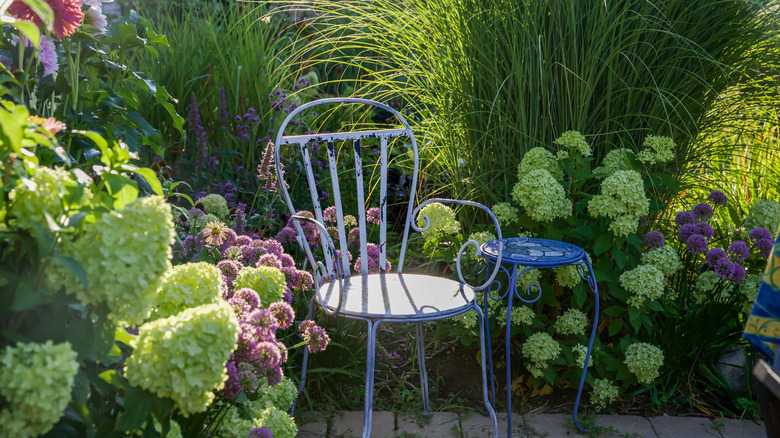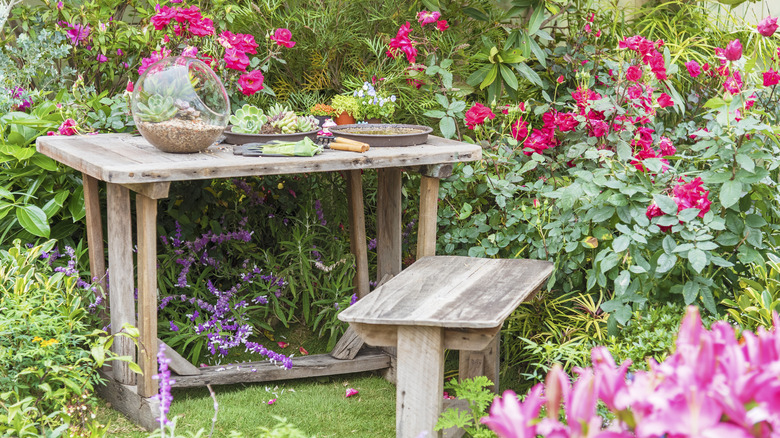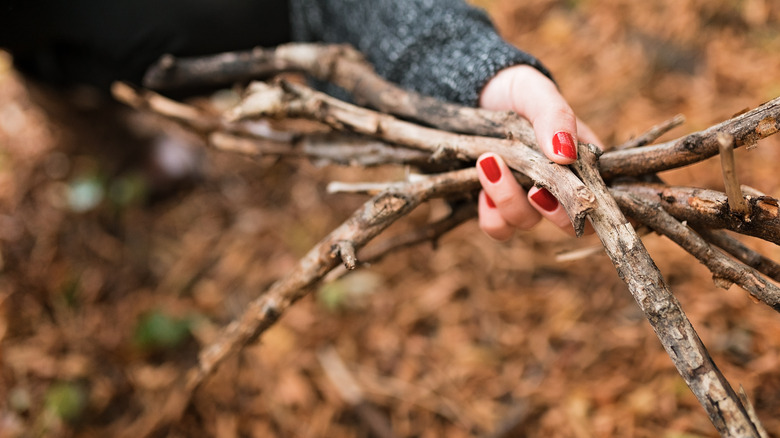What Is A Vintage Farmhouse Garden (& How To Make One Yourself)
We may receive a commission on purchases made from links.
If your yard looks dull, planting summer-blooming perennials for a colorful garden will only do so much. Instead, embrace the vintage farmhouse garden style to breathe life into the dreary space. To understand what it is and why it's unique, House Digest sat down for an exclusive interview with Rhonda Kaiser, author of The Vintage Farmhouse Garden and owner of Southern Home and Farm. Explaining the concept, she says, "In essence, it's a lived-in, welcoming garden that appears to have been lovingly tended over generations. Instead of clean lines and modern edges, you see weathered surfaces, repurposed items, layered plantings, and a laid-back combination of form, function, and beauty. They are timeless, cozy, and deeply connected to history and nature."
Think of it as a garden that feels like a warm hug. Opening up about why this aesthetic works well, Kaiser notes, "The vintage farmhouse look speaks to us so strongly because it combines comfort, history, and nature in a design that is forever classic." Wondering how you can imitate this style in your home? Kaiser mentions you don't have to try too hard; true beauty lies in embracing the imperfections. "A true farmhouse garden doesn't look too perfect. Let the patina show, let the roses ramble, and embrace that touch of wild — it's the mix of old, natural, and slightly imperfect that makes it feel alive and magical." Use vintage pieces, like country lanterns, as well as functional items, such as a beautiful potting station. Kaiser encourages us to decorate a space that's "... nostalgic without feeling outdated, rustic yet elegant, and above all — it feels lived-in and approachable."
Elements required for a farmhouse-inspired garden
Layering is an important part of a farmhouse-inspired garden. Speaking of the individual elements and how to make them work together, Kaiser elaborates in her House Digest exclusive interview: "When creating a farmhouse-inspired garden, consider layering together plants (like cottage favorites, herbs, and cut flowers), materials, and hardscaping (such as arbors, troughs, Adirondack chairs, and porch swings)." Once you have the bare bones in place, she suggests adding "vintage and repurposed accents (old enamelware reused as planters, antique signs, weathered shutters, or even ladders repurposed as vertical garden support)." If you think an item will add an old-world charm to your boring space, give it a little room in your garden.
Finally, tie all of it together with "functional-yet-beautiful touches (a potting bench or garden hutch, a farmhouse table outdoors, or even a rustic outdoor sink)." Although there are no strict rules about what you can include and what you can't, don't be afraid to experiment. For instance, you can sprinkle in elements with a beautiful history or ones that evoke beautiful memories and feel personal. Kaiser explains, "Personal touches make these areas especially charming — like my vintage Christmas sign that I hang above my greenhouse, or my antique European goose that I display in my silo during the holiday season, trimmed with delicate vintage ribbons sourced from a trimmings store in Manhattan." When asked why these elements work so well together, she remarks, "Because they carry a sense of timelessness — vintage pieces naturally enhance the old-world charm of a carefully curated garden." So, steer clear of contemporary pieces since they'll look out of place in such a setting.
How to bring the farmhouse gardening aesthetic home
Although it can feel like a lot, the farmhouse gardening aesthetic can be relatively budget-friendly if you know where to look. Sharing the tips on how to bring it home without throwing your budget in disarray, in her exclusive interview with House Digest, Kaiser suggests using items you already have. She says, "A thrifty way to introduce a farmhouse feel into your yard is to reuse what you already have on hand." So, always shop your home before you think of buying anything new. Things you find in and around your yard can be used, too. "I've gathered broken branches to design an artful autumn display by the front door, and even suspended branches from the greenhouse ceiling, letting greenery trail down to create a warm, welcoming atmosphere," Kaiser explains.
Looking for elements that will spice up your boring garden year-round? She continues, "Potted flowers, herbs, and cuttings frequently find their way to the center of my farmhouse table, and I also use these materials in 'living wreaths' that add a touch of life and beauty throughout the garden." Simply put, don't limit yourself to any single item. Explore and see what works best in your space. You'll also need seating and furniture, as they set the tone. To add a little depth, play around with different textures and materials to transform common thrift store finds into beautiful garden decor. Regarding plants, Kaiser shares, "Garden styling ties it all together with cottage classics such as roses, lavender, peonies, and hollyhocks; drama and romance [are] provided by climbing vines like clematis or wisteria over arbors or fences, and tumbling containers give a sense of effortless abundance."


